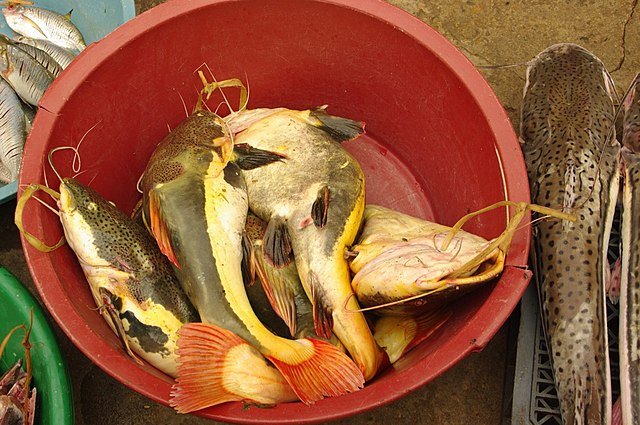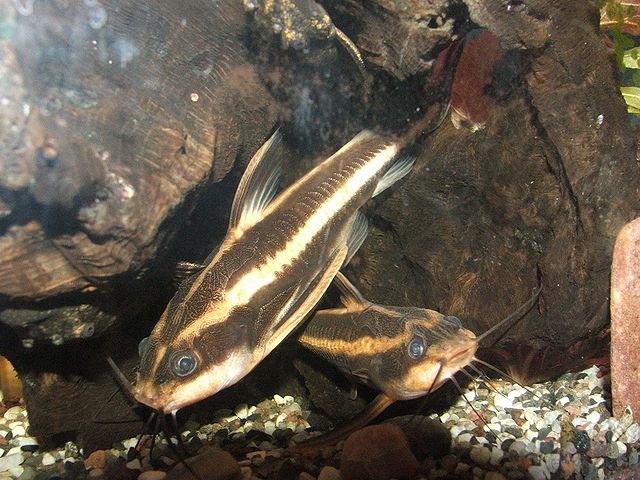The Redtail Catfish (Phractocephalus hemioliopterus) is a fascinating and charismatic species native to the Amazon and Orinoco river basins in South America. Instantly recognizable by its distinctive orange or red caudal fin, this gentle giant is a common presence in public aquariums and, for some experienced hobbyists, in large private aquariums.
In recent years, there has been growing interest in developing the aquaculture of this catfish, not only for its potential as an ornamental fish but also for its economic importance as a source of food and income for riparian communities, where it is highly valued by fishermen.
Despite its popularity, the Redtail Catfish presents significant challenges for keeping in captivity, mainly due to its impressive final size and rapid growth. This updated guide aims to provide comprehensive information about the Redtail Catfish, covering its main characteristics, feeding, breeding, care requirements, compatibility, potential size, and the essential considerations before acquiring one as a pet.
What is the Redtail Catfish?
Taxonomy
- Kingdom: Animalia
- Phylum: Chordata
- Class: Actinopterygii
- Subclass: Neopterygii
- Infraclass: Teleostei
- Superorder: Ostariophysi
- Order: Siluriformes
- Family: Pimelodidae
- Genus: Phractocephalus
- Species: Phractocephalus hemioliopterus (Formerly Silurus hemioliopterus, Phractocephalus bicolor)
Common names (Spanish/Regional): pez gato cola roja, pez torre (Peru), general (Bolivia), Pirarara (Brazil), bagre guacamayo (Ecuador) and cajaro pez (Colombia and Venezuela), bagre de cola roja, bagre cola roja.
Common names (English): redtail catfish, banana catfish, flat-nosed catfish, antenna catfish, and South American redtail.
Important Note: Sometimes the term “Asian Redtail Catfish” is mentioned. It is crucial to understand that this name generally refers to a different species, Hemibagrus wyckioides, native to Asia. Although both are large catfishes, they are not directly related and have different appearances and requirements. This guide focuses exclusively on the South American Phractocephalus hemioliopterus.
Characteristics of the Redtail Catfish
The “pirarara” (P. hemioliopterus) is the most colorful of the giant Neotropical catfishes of the Pimelodidae family (Souza et al., 2012). The redtail catfish has a fusiform shape; in the wild, redtail catfish can exceed 1.5 meters (5 feet) in length and weigh over 80 kg (180 lbs). Although they rarely reach these dimensions in aquariums, they can easily reach 1-1.2 meters (3-4 feet). The largest recorded redtail catfish is a subject of debate, but specimens over 1.5 meters are not unheard of in their natural habitat.
The redtail catfish has a robust and elongated body, dark brown to black on the back, a creamy white belly, and a distinctive white lateral stripe running from the head to the caudal fin. Its most striking feature is the intense red or orange caudal fin. It possesses three pairs of sensitive barbels (two on the lower jaw, one on the upper jaw) which it uses to detect food in murky waters.
Stay Always Informed
Join our communities to instantly receive the most important news, reports, and analysis from the aquaculture industry.
Phractocephalus hemioliopterus exhibits black-brown coloration on the upper part, with yellow sides and a white belly. The main characteristic of this catfish is its entirely red tail.
Redtail catfish can live for 15 to 20 years.

Variations and Hybrids
In addition to the wild form, some popular variations and hybrids exist in the aquarium trade:
- Albino Redtail Catfish: A variation lacking dark pigmentation, resulting in a creamy white or yellowish body with the characteristic red/orange tail. Its eyes are usually pink or red. Care is identical to that of the normal form.
- Platinum Redtail Catfish: Similar to the albino, but often with a more metallic or silvery sheen on the body. Sometimes the terms “albino” and “platinum” are used interchangeably in the trade.
- Redtail Catfish Hybrid: Hybrids are common, especially the cross between the Redtail Catfish (Phractocephalus hemioliopterus) and the Tiger Shovelnose Catfish (Pseudoplatystoma fasciatum or P. tigrinum). These hybrids often combine patterns and colors from both species and are equally large and voracious.
Habitat
The Redtail Catfish is native to South America. It is primarily found in the basins of the Amazon, Orinoco, and Esequibo rivers, in countries such as Ecuador, Venezuela, Guyana, Colombia, Peru, Bolivia, and Brazil. This catfish species has been introduced to Florida (United States), Japan, and Malaysia.
It mainly inhabits the bottom of the main river channels and large streams. It is often found in rapids (cachuelas).
Feeding Redtail Catfish
The redtail catfish is an omnivore with strong carnivorous/piscivorous tendencies, especially as it grows. They are opportunistic and not picky eaters.
Diet in Captivity:
- Base: High-quality commercial foods for large catfish or carnivorous fish (sinking pellets).
- Supplements: A varied diet is essential. Include frozen or fresh foods such as whole fish (tilapia, smelt), shrimp, large earthworms, mussels, squid.
- Live Foods: Can be offered occasionally (home-raised feeder fish to avoid diseases), but should not be the staple of the diet due to the risk of parasites and nutritional imbalances. Avoid goldfish as feeders, as they are nutritionally poor and can cause health problems.
- Vegetable Matter: They may occasionally consume vegetable matter, although it is not a primary component of their diet.
Feeding Juveniles: Juvenile redtail catfish eat eagerly. In this regard, de Oliveira et al. (2023) determined that juvenile redtail catfish adapt quickly to self-feeding systems and prefer to feed at night; in this sense, offer them smaller, more frequent portions of food appropriate to their size: small pellets, fish pieces, small shrimp, chopped earthworms.
Feeding Frequency: Juveniles grow fast and should be fed daily or every other day. Large adults can be fed 2-3 times per week. It is easy to overfeed them, which contributes to obesity and water quality problems. Observe the fish’s body condition.
Feeding Behavior: They have large mouths and a voracious appetite. They consume food quickly.
Reproduction
Breeding the redtail catfish in home aquariums is extremely rare and practically impossible for the average hobbyist due to several factors:
- Size: Sexually mature adult specimens are needed, which are already enormous.
- Space: They would require a tank or pond of colossal dimensions (tens of thousands of liters / thousands of gallons) to simulate natural spawning conditions.
- Sexual Dimorphism: It is very difficult to distinguish males from females externally. However, during the breeding season, female redtail catfish usually have a more rounded belly.
- Spawning: In the wild, they undertake migrations to spawn. Replicating these triggers in captivity is complex. Redtail catfish reproduce through external fertilization after the female lays her eggs. Da costa et al. (2024) report hormonal induction of male redtail catfish using a single intramuscular injection of 4 mg/kg of carp pituitary extract (CPE). Furthermore, a female redtail catfish can lay a total of 300,000 to 500,000 eggs.
- Commercial Aquaculture: Commercial breeding is usually carried out in large earthen ponds in tropical regions, often using hormonal induction (with hormones like carp pituitary extract) to stimulate synchronized spawning. This underscores the growing interest in the aquaculture of this species. The complete redtail catfish life cycle, from egg to mature adult, can take several years. In this regard, Freitas et al. (2019) report that in their natural environment, the redtail catfish P. hemioliopterus reaches its first sexual maturity at a size of 77.8 cm.
Aquarium Care
Keeping a Redtail Catfish is a long-term commitment that requires considerable planning and significant resources, primarily due to its size and growth rate.
- Tank Size: Absolutely crucial! A juvenile specimen can start in a tank of about 200-300 liters (55-75 gallons), but this is temporary. Given its rapid growth rate, an adult will require an aquarium of thousands of liters (at least 2000-4000 liters or 500-1000 gallons), and preferably much larger, such as an indoor pond or a custom-built aquarium. Smaller tanks will result in chronic stress, health problems, and a shortened lifespan. The maximum size a redtail catfish can reach in an aquarium will largely depend on the available space, but even in huge tanks, they rarely exceed 1.2 meters.
- Filtration: These fish are large and produce a significant amount of waste. Extremely powerful filtration (large sump filters, high-performance canister filters) is needed to maintain water quality. Large and regular water changes (30-50% weekly) are essential.
Success in raising redtail catfish, and any fish, in addition to good nutrition, involves providing the water quality parameters for them to grow in a healthy environment and allow these fish to thrive.
Table 01. Water quality parameters for the care of Redtail catfish.
| Parameter | Range |
| Aquarium Size | Over 1000 liters for juveniles Over 10,000 liters for adults |
| Water Temperature | 20 – 26 oC (68-79 °F) |
| pH | 5.5 – 6.8 |
| Hardness (GH) | 2 – 10 |
| Lighting | They prefer dim lighting. |
- Substrate and Decoration: A soft substrate (fine sand or rounded gravel) is preferable to protect their sensitive barbels. They need plenty of open space for swimming. Decorations must be large, sturdy, and safe (large smooth rocks, large driftwood), as they can move or destroy smaller objects. Juveniles appreciate caves or hiding places where they can feel secure.
On another note, if you need to transport or monitor the growth of juvenile redtail catfish, a eugenol concentration of 70 mg/L can be used to promote anesthetic induction in the fish (Dutra et al., 2021).
Compatibility and Behavior
- Temperament: Despite their size, they are surprisingly peaceful towards fish they cannot swallow. However, they are voracious predators by nature. Golden rule: if it fits in its mouth, it will eat it. This includes fish, invertebrates, loose decorations, and even heaters or filter tubes if not protected. In this regard, juvenile redtail catfish may prey on other fish in community aquariums (e.g., tetras or guppies).
- Tank Mates: Extremely limited. Only very large, robust fish with a similar temperament that cannot fit into its mouth. Even so, a gigantic tank is needed to minimize territorial aggression. Often, the best option is to keep them alone.
- Behavior: They are primarily nocturnal or crepuscular, but will become more active during the day, especially at feeding time, once acclimated. They spend a lot of time resting on the bottom or in their preferred hiding places.

Diseases
Ich or white spot disease
Neto and Souto (2020) treated Ich in Phractocephalus hemioliopterus specimens with sodium chloride in short baths at a concentration of 3%, resulting in a reduction in mortality.
Parasites
Oliveira et al. (2019) report that crustaceans such as Argulus multicolor, Argulus violaceus, Dolops nana, Dolops discoidalis, and Braga patagonica infest P. hemioliopterus, with Dolops discoidalis being the dominant ectoparasite.
Redtail catfish is infested by a series of ectoparasites that cause skin wounds. Andrade et al. (2023) determined that a topical treatment with 10 grams/m3 of potassium permanganate and 2 grams/m3 of methylene blue is suitable for curing the fish.
Aeromonas
Caballero et al. (2024) first described the association between Aeromonas spp. and extensive multifocal necrosis of perivisceral adipose tissue in acute deaths of redtail catfish (Phractocephalus hemioliopterus) kept under human care.
Economic and Nutritional Value of Redtail Catfish
Redtail catfish are highly valued by fishermen in riverine communities as a source of food and income. Additionally, in some regions, the fat and leather of the fish are used in folk medicine for respiratory problems.
In this regard, Pinto and Maduro (2003) report that one of the most commonly used animal products in folk medicine in the city of Boa Vista (Roraima, Brazil) is pirarara lard.
Redtail catfish is part of the diet of Amazonian peoples, being captured alongside other catfish species and sold in regional markets.
Sotelo et al. (2008) report that the protein content of Redtail catfish is 14.74%, and the moisture content is 81.8%. They also highlight that Redtail catfish has potential for surimi production and derived products. Alves (2023) developed a canned product from pirarara (Phractocephalus hemioliopterus Bloch & Schneider, 1801) and reported that it was well-accepted by the evaluating panel.

Conclusion
The Redtail Catfish is undeniably an impressive and charismatic fish. However, its enormous potential size, rapid growth, longevity, and the need for a “gigantic” tank make it an unsuitable choice for the vast majority of home aquarists.
Before considering the purchase of a redtail catfish specimen, honestly evaluate if you can provide the massive space (thousands of liters / hundreds or thousands of gallons), powerful filtration, and long-term commitment (15-20+ years) that this giant requires. Caring for a redtail catfish is an enormous responsibility.
While its breeding is a challenge primarily reserved for commercial operations and its diet is relatively simple to satisfy, the space demands far exceed the capabilities of most. Research thoroughly, consider smaller alternatives, and always practice responsible aquatic pet keeping. The animal’s welfare must always be the top priority.
References
Andrade, R. B., Fernandes, M. P., Rezende, M. T. N. P., Alves, T. R. de O., & Rodrigues, L. (2023). Uso do azul de metileno e permanganato de potássio em lesão cutânea de Phractocephalus Hemioliopterus. Pubvet, 17(04), e1371. https://doi.org/10.31533/pubvet.v17n04e1371
Alves, C. S. S. (2023). Elaboração de conserva de pirarara (Phractocephalus hemioliopterus Bloch & Schneider,1801) [Trabalho de Conclusão de Curso (Agronomia), Universidade Federal do Amazonas, Manaus, AM].
Caballero Hernández, L., Castro Alonso, A., Caballero Cansino, M. J., Curros Moreno, Á., Montero Hernández, G., Padilla Castillo, D., … & Montesdeoca Morales, E. (2024). Association of Aeromonas spp. with mortality and perivisceral adipose tissue necrosis in redtail catfish (Phractocephalus Hemioliopterus).
Da Costa, B. B., Rodrigues, R. B., Povh, J. A., Sanches, E. A., Teixeira, N. D. S., França, T. D. S., Spica, L. N., Machado, T. L. F., Benato, J. L., Stawinski, C. V., Kasai, R. Y. D., & Streit Jr, D. P. (2024). Descriptive analysis of the sperm of three South American catfish species maintained ex situ and the influence of morphology on sperm movement. Theriogenology Wild, 4, 100080. https://doi.org/10.1016/j.therwi.2024.100080
de Oliveira Guilherme, H., Perez Ribeiro, P. A., Prado, V. G. L., Bahiense, R. N., Gamarano, P. G., de Oliveira, C. G., de Almeida Freitas, D., & Costa, L. S. (2023). Feeding behaviour, locomotion rhythms and blood biochemistry of the neotropical red-tail catfish (Phractocephalus hemioliopterus). Journal of Fish Biology, 102( 4), 803– 815. https://doi.org/10.1111/jfb.15317
Dutra, Janaína Alves, Garcia, Ronielson Soares, Araújo, Mollynsk Oliveira, Menezes, Ludmila Lopes de Castro, Souto, Cristielle Nunes. 2021. AVALIAÇÃO DO TEMPO DE INDUÇÃO E RETORNO COM O USO DO EUGENOL EM PIRARARA (Phractocephalus hemioliopterus). Aquaciencia Digital 2021.
EcuRed. Pez gato cola roja
Freitas, T. M. D. S., & Montag, L. F. D. A. (2019). Population and reproductive parameters of the red-tailed catfish, Phractocephalus hemioliopterus (Pimelodidae: Siluriformes), from the Xingu River, Brazil. Neotropical Ichthyology, 17.
Neto, J. M. D. S., & Souto, C. N. 2020. PIRARARA (Phractocephalus hemioliopterus) LEUCÍSTICA INFECTADA POR Ichthyophthirius multifiliis: RELATO DE CASO.
Oliveira, M. S. B., Corrêa, L. L., Gonçalves, R. A., Neves, L. R., Prestes, L., Ferreira, D. O., & Tavares-Dias, M. (2019). Nuevos registros de crustáceos que infestan Phractocephalus hemioliopterus (Siluriformes: Pimelodidae), el gran bagre del Amazonas. Revista mexicana de biodiversidad, 90.
Peces de Bolivia. Phractocephalus hemioliopterus
PINTO, A. A. D. C., & MADURO, C. B. (2003). Produtos e subprodutos da medicina popular comercializados na cidade de Boa Vista, Roraima. Acta Amazônica, 33, 281-290.
Seriously Fish. Phractocephalus hemioliopterus: Red-tail Catfish
Sotelo D, Indira, Filomena A, Annamaria, & Rodríguez P, Jenny. (2008). EVALUACIÓN DE LAS PROPIEDADES DEL CAJARO (Phractocephalus hemiliopterus) COMO POTENCIAL PARA LA OBTENCIÓN DE SURIMI Y PRODUCTOS DERIVADOS. Revista MVZ Córdoba, 13(3), 1456-1463.
Souza, C. A., Hashimoto, D. T., Pereira, L. H. G., Oliveira, C., Foresti, F., & Porto-Foresti, F. (2012). Development and characterization of microsatellite loci in Phractocephalus hemioliopterus (Siluriformes: Pimelodidae) and their cross-species amplification in six related species. Conservation Genetics Resources, 4, 499-501.
Editor at the digital magazine AquaHoy. He holds a degree in Aquaculture Biology from the National University of Santa (UNS) and a Master’s degree in Science and Innovation Management from the Polytechnic University of Valencia, with postgraduate diplomas in Business Innovation and Innovation Management. He possesses extensive experience in the aquaculture and fisheries sector, having led the Fisheries Innovation Unit of the National Program for Innovation in Fisheries and Aquaculture (PNIPA). He has served as a senior consultant in technology watch, an innovation project formulator and advisor, and a lecturer at UNS. He is a member of the Peruvian College of Biologists and was recognized by the World Aquaculture Society (WAS) in 2016 for his contribution to aquaculture.




